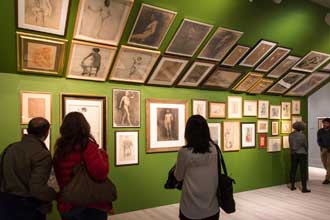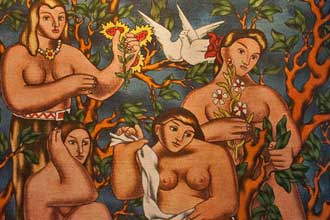An Examination Of The Nude Figure In Turkish Art At The Pera Museum
By Susanne Fowler
JAN. 4, 2016
ISTANBUL — As an increasingly conservative Turkey grapples with questions of free expression, it might seem to be a risky time for an exhibition examining how Turkish artists fought cultural restrictions a century ago in order to paint the nude figure.

Photo: “Bare, Naked, Nude: A Story of Modernization in Turkish Painting” at the Pera Museum in Istanbul looks at how artists fought cultural restrictions a century ago in order to paint the nude figure. Credit Pera Museum.
The show, “Bare, Naked, Nude: A Story of Modernization in Turkish Painting,” at the Pera Museum here until Feb. 7, examines how the genre of the nude emerged from behind studio curtains in the transition from Ottoman rule to a new republican state.
At the Pera, early anatomical studies of men by male artists, and of women by female artists, are set against more stylized, later depictions like “Hamam,” a 1952 gouache on paper by Bedri Rahmi Eyuboglu that shows a female form cocooned inside a structure with domes and minarets.
The evolving acceptance of the nude figure in Turkish art reflected the country’s wider aspirations, the exhibition’s curator, Ahu Antmen, said in an interview at the museum. “It was very important at the time for Turkey to show it had become a secular, modernized nation-state,” she said.

Photo: Neset Gunal’s “Four Beauties” (1951). Credit Gregory M. Kiez & Mehmet Kutman Foundation Collection.
Yet the place of the nude in Turkish art remains a delicate issue. “In today’s secular, modernized Turkey, many aspects of traditional culture remain,” she said, adding, “This was the case in the early years of the Turkish Republic, and it remains so today. The art context remains irrelevant for many people when nudity is involved.”
The mood in Turkey under President Recep Tayyip Erdogan and his Islamist party could be described as one of self-censorship, reinforced by developments like the recent arrests of two prominent journalists on espionage charges and the dismissal from his public health job of a doctor who shared a social media post comparing Mr. Erdogan to Gollum from the “Lord of the Rings” movies.
The crackdown has largely centered on political expression, but Ms. Antmen acknowledged that an exhibition featuring nudes could upset some people. “Religion is a very significant part of Turkish culture, although Turkey is a secular state,” she said. “The nude is an interesting topic because it challenges the Islamic worldview that women should be veiled.”
As of Monday, the museum had received no official complaints and the show was being advertised at Istanbul Ataturk Airport and with a huge banner on the museum’s facade.
Wendy Shaw, a professor of the arts of Islamic cultures at the Free University Berlin, said that the Pera exhibition could be interpreted as an act of political resistance.
However, Ms. Shaw added, “it’s also important to remember that the Turkish government is just fine with the urban elite engaging with this stuff — and with such a museum giving a ‘modern’ look to the country — but such museums are not part of broad public practices, and never have been.” The private Pera Museum was opened in 2005 by the Suna and Inan Kirac Foundation, which was set up by a family with ties to Koc Holding, an industrial conglomerate in Turkey.
Ms. Antmen said that she understood the urge to read politics into the exhibition’s motives, but explained: “I had no such intention. This is an art historical survey of an artistic genre.”
“But it is interesting that this exhibition can be seen in that way, and is very reflective of the times in which we are living,” she added. “It’s a reflection of Turkey’s unique traditionalism and modernity.”
Drawing the human form from live models was long considered a rite of passage — and an academic requirement — for aspiring artists in the West, but Turkish artists under Ottoman rule had to do so clandestinely, Ms. Antmen said, under threat from the authorities or conservative groups.
The first Turkish art academy, founded in 1882 for male students, was part of the transition toward a more Western-oriented culture in the Ottoman Empire, Ms. Antmen said. But working from live nude models was prohibited until just before the Second Constitutional Era in 1908.
“And all those models were male,” she said, typically wrestlers or porters with well-defined musculature. Conversely, when an art academy for women was established in 1914, those students were allowed to work with nude models, but only if the models were women.
Paintings of female nudes were first exhibited in Turkey in 1922 at the annual Galatasaray Exhibition in Istanbul, Ms. Antmen said, during “a time of utmost political turmoil for Turkey, with the occupation of Istanbul and the ongoing war of independence.”
It took some doing, however, to reach the point at which such art could be publicly displayed. In his memoirs, the artist Hikmet Onat, who studied at the men’s academy from 1905 to 1910, tells how male students campaigned to be able to draw female nudes, but the school’s teacher, Osman Hamdi Bey, a prominent painter and archaeologist, refused, fearing it would cause an uproar among religious conservatives who might demand the school be closed.
But after 1923, when Mustafa Kemal Ataturk founded the modern Turkish Republic, the culture of the country, and the art academies, shifted. In 1927, both male and female nude models were used in coeducational classes, Ms. Antmen said.
“A lot of the artists who produced nude paintings in their early years shifted later toward other genres, like still life or landscape,” said Ms. Antmen, who is also an associate professor of art history at Marmara University in Istanbul. “But early on, the painting of the nude figure was a kind of statement for these artists, a kind of mission: They had to prove they could do it, as the face of a new nation.”
Finding the works that showed this transition was a challenge, Ms. Antmen said, because of the revealing nature of some of them, and the fact that many were hidden in private collections. Other potential inclusions might have been deliberately destroyed, or sat unrecognized inside junk shops. “Sometimes it felt like looking for a pin in a haystack,” she added.
She tried to borrow from the national painting and sculpture museums in Istanbul and Ankara, but was told they were closed for inventories, she said. Other private museums and collectors were willing to lend works, like “Woman and Swan,” a 1922 oil painting by Ibrahim Calli from the Sakip Sabanci Museum, and “Nude, Undated” by Melek Celal Sofu, from the Cem Mesrur Paksoy collection.
“I am trying to show that the painting of nudes was among the preferred genres for Turkish artists in the first half of the 20th century, part of an aesthetic culture in Turkey,” Ms. Antmen said.
Source: The New York Times.




 Moderate Islamist here
Moderate Islamist here


0 comments:
Post a Comment